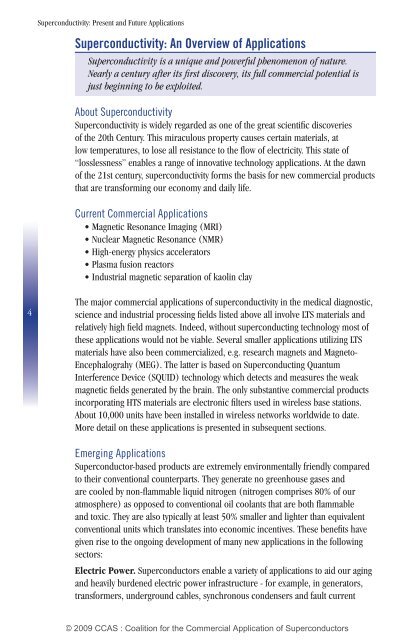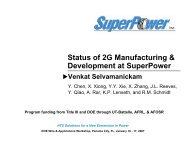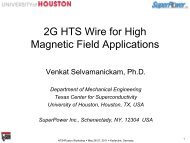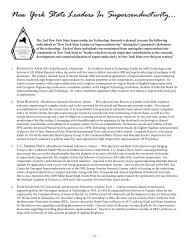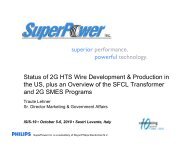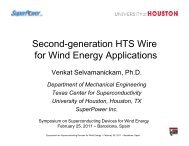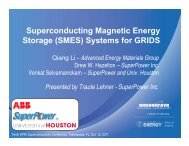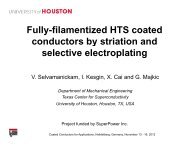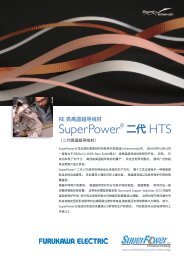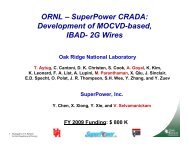superconductivity - CCAS - Coalition for the Commercial Application ...
superconductivity - CCAS - Coalition for the Commercial Application ...
superconductivity - CCAS - Coalition for the Commercial Application ...
You also want an ePaper? Increase the reach of your titles
YUMPU automatically turns print PDFs into web optimized ePapers that Google loves.
Superconductivity: Present and Future <strong>Application</strong>s<br />
Superconductivity: An Overview of <strong>Application</strong>s<br />
Superconductivity is a unique and powerful phenomenon of nature.<br />
Nearly a century after its first discovery, its full commercial potential is<br />
just beginning to be exploited.<br />
About Superconductivity<br />
Superconductivity is widely regarded as one of <strong>the</strong> great scientific discoveries<br />
of <strong>the</strong> 20th Century. This miraculous property causes certain materials, at<br />
low temperatures, to lose all resistance to <strong>the</strong> flow of electricity. This state of<br />
“losslessness” enables a range of innovative technology applications. At <strong>the</strong> dawn<br />
of <strong>the</strong> 21st century, <strong>superconductivity</strong> <strong>for</strong>ms <strong>the</strong> basis <strong>for</strong> new commercial products<br />
that are trans<strong>for</strong>ming our economy and daily life.<br />
Current <strong>Commercial</strong> <strong>Application</strong>s<br />
• Magnetic Resonance Imaging (MRI)<br />
• Nuclear Magnetic Resonance (NMR)<br />
• High-energy physics accelerators<br />
• Plasma fusion reactors<br />
• Industrial magnetic separation of kaolin clay<br />
4<br />
The major commercial applications of <strong>superconductivity</strong> in <strong>the</strong> medical diagnostic,<br />
science and industrial processing fields listed above all involve LTS materials and<br />
relatively high field magnets. Indeed, without superconducting technology most of<br />
<strong>the</strong>se applications would not be viable. Several smaller applications utilizing LTS<br />
materials have also been commercialized, e.g. research magnets and Magneto-<br />
Encephalograhy (MEG). The latter is based on Superconducting Quantum<br />
Interference Device (SQUID) technology which detects and measures <strong>the</strong> weak<br />
magnetic fields generated by <strong>the</strong> brain. The only substantive commercial products<br />
incorporating HTS materials are electronic filters used in wireless base stations.<br />
About 10,000 units have been installed in wireless networks worldwide to date.<br />
More detail on <strong>the</strong>se applications is presented in subsequent sections.<br />
Emerging <strong>Application</strong>s<br />
Superconductor-based products are extremely environmentally friendly compared<br />
to <strong>the</strong>ir conventional counterparts. They generate no greenhouse gases and<br />
are cooled by non-flammable liquid nitrogen (nitrogen comprises 80% of our<br />
atmosphere) as opposed to conventional oil coolants that are both flammable<br />
and toxic. They are also typically at least 50% smaller and lighter than equivalent<br />
conventional units which translates into economic incentives. These benefits have<br />
given rise to <strong>the</strong> ongoing development of many new applications in <strong>the</strong> following<br />
sectors:<br />
Electric Power. Superconductors enable a variety of applications to aid our aging<br />
and heavily burdened electric power infrastructure - <strong>for</strong> example, in generators,<br />
trans<strong>for</strong>mers, underground cables, synchronous condensers and fault current<br />
© 2009 <strong>CCAS</strong> : <strong>Coalition</strong> <strong>for</strong> <strong>the</strong> <strong>Commercial</strong> <strong>Application</strong> of Superconductors


